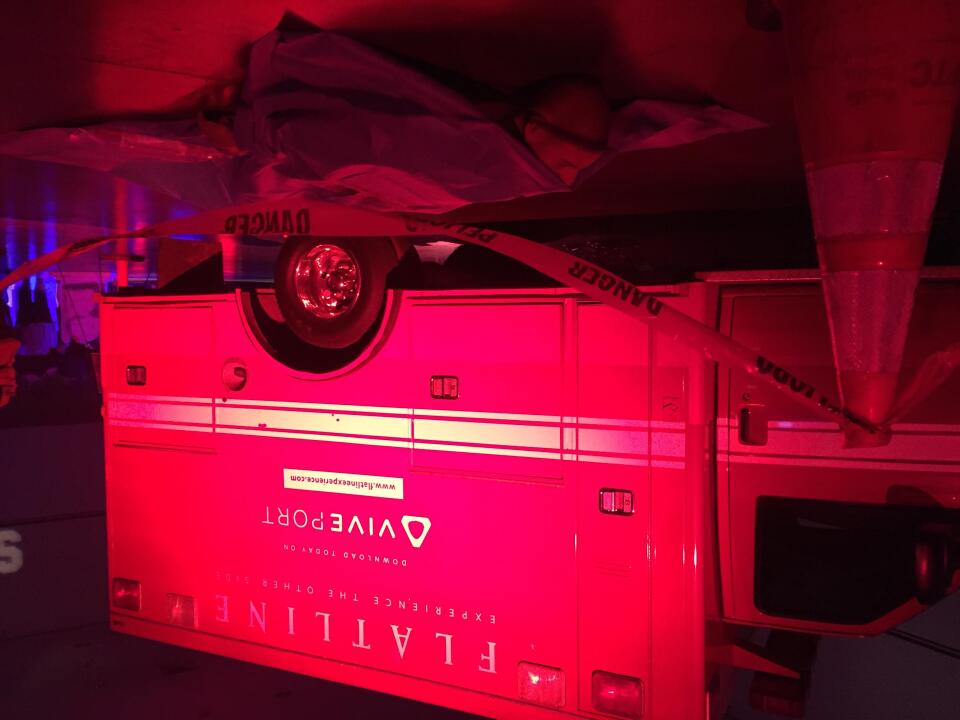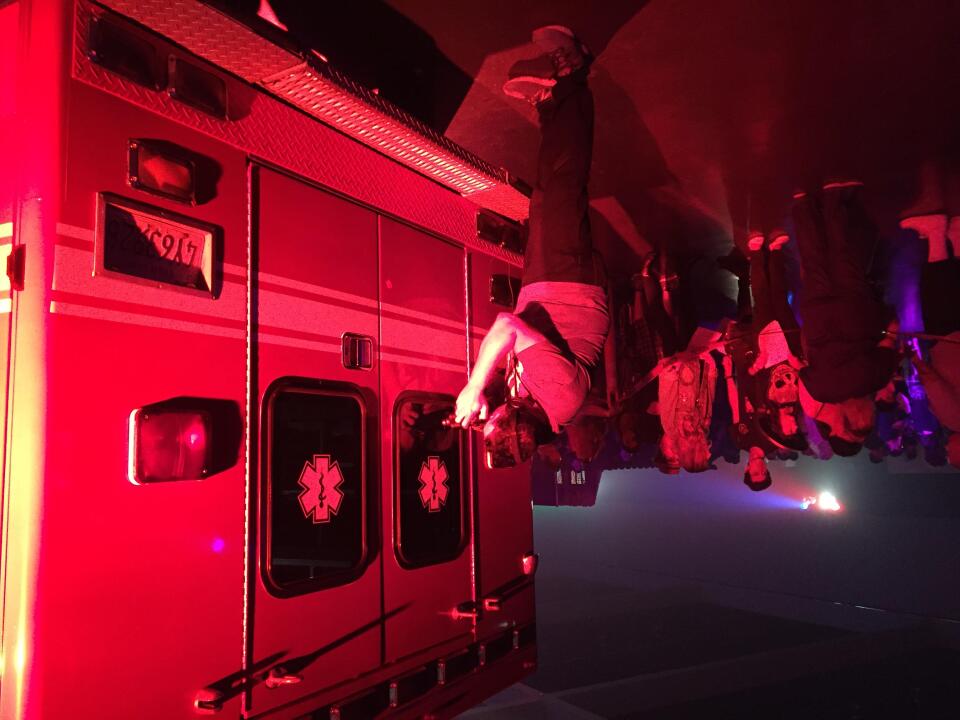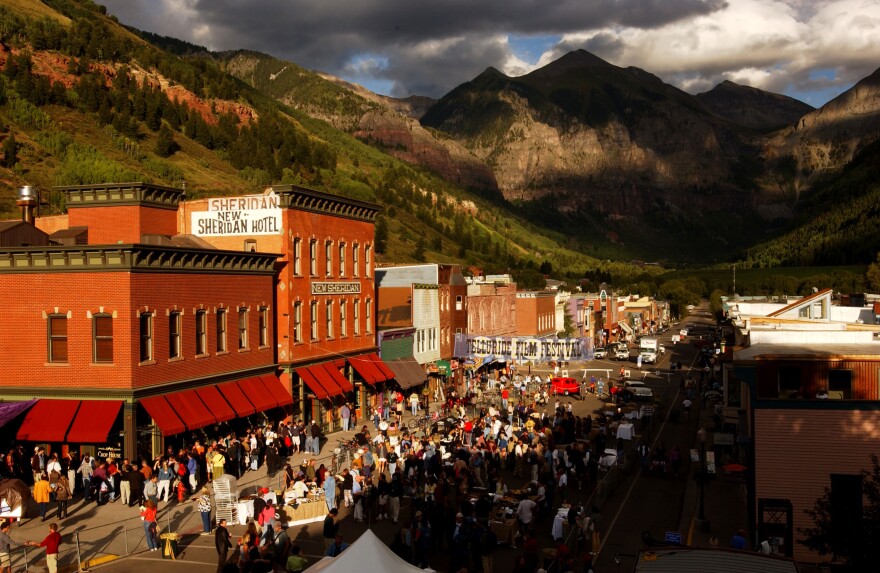The Telluride festival has become a reliable bellwether for Academy Award attention; Kira Kelly is a Hollywood rarity: an African-American female cinematographer; behind the scenes with the sound engineers at the Bowl.
Kira Kelly is a Hollywood rarity: A female, African-American cinematographer
Cinematographer Kira Kelly worked her way up in the film biz working in the electrical department as a gaffer on films and TV shows. But she always dreamed of being the one handling a camera.
Like a lot of people trying to make it in the biz, she picked up camera work jobs on the side of her day job, until one day she just decided it was time to prioritize her passion.
She first started shooting for music videos, until one day she got a call from director Ava Duvernay's assistant, asking for a meeting. She jumped at the chance, of course.
"We ended up meeting up about this [virtual reality] project that didn't end up happening, but she said, 'By the way, I'm working on this documentary, would you like to be a part of it? And of course, the answer is Yes, yes, yes! So, she started telling me about '13th.' and that's how I got on board," said Kelly on The Frame.
"13th," examines the evolution of slavery into mass incarceration in the United States. Instead of standard talking heads, Kelly worked with DuVernay and co-director of photography, Hans Charles, to create a gritty visual style, creatively framing subjects in industrial locations.
DuVernay has been an outspoken proponent for inclusive casting and hiring practices. For the OWN Network family drama, "Queen Sugar," DuVernay hired female directors to helm every episode. And for the second season, she tapped Kelly as cinematographer.
"Queen Sugar" follows the dramatic encounters of a storied African-American family in New Orleans, while bringing to light topical issues faced by the black community.
To lens the second season's lush visuals and tense scenes, Kelly draws from her background in cinematography for documentaries, as well as narrative projects like "East Los High."

As an African-American and woman, Kelly is a rarity in her field, but she hopes to that will change thanks to inclusive hiring practices she's learned from DuVernay. When she stopped by The Frame, Kelly talked about how she got her start in the industry.
INTERVIEW HIGHLIGHTS:
On how her career began:
I started out as an electrician, in the lighting department. While I was there I was already shooting stuff, I'd shoot any project that I could get my hands on. I went to film school for cinematography, and then slowly but surely I moved up to gaffing. I was able to work on projects with much bigger budgets as a gaffer than I had when I was shooting. So I was able to learn a lot.
On working with Ava DuVernay:
She started following me on social media, and I was like, Oh, that's fun! At one point, I got an email from one of her assistants saying, "Ava wants to meet with you. Would you be interested?" I said, Of course! We ended up meeting up about this [virtual reality] project that didn't end up happening, but she said, "By the way I'm working on this documentary, would you like to be a part of it?" And of course, the answer is Yes, yes, yes! So, she started telling me about "13th." and that's how I got on board.
On approaching documentaries as opposed to narrative fiction:
I feel like documentary is a great place to work on improvisation. When I work on "Queen Sugar," I have a wonderful, huge crew behind me. They're ready, they're supportive. We've got two cameras, camera operators, it's a big crew. Whereas documentaries, usually it's just me and maybe a camera assistant; there's a gaffer, key grip helping with lighting. But it's much smaller. In a lot of cases, you are going to these places you haven't seen before, you haven't prepped it. You know vaguely where the sun is going to be, but you go in and you have to find a way to make that work for the next two hours of an interview.
There's a lot of variables that you don't have time to prep [for] and figure out. It's a great way to keep that improvisational mind going when you go and work in narrative stuff. In narrative, you have the support behind you. You have the equipment. You have the prep, and all that. But sometimes things change, and that documentary mindset helps you work more on your toes.
On DuVernay's choice to hire all women directors:
What's great about what Ava wanted to do is that these are directors that may have done a few feature films, but hadn't gotten their foot in the doors as far as working in television. So, they brought some really great and inspiring ideas to the set. Their influence and their input tapped into a bit of the artistry aspect.
I think the set and the cast are so inviting. People say this all the time, but for "Queen Sugar," it feels like a family. It's a really inspiring place to be.
On having Oprah Winfrey as an executive producer on 'Queen Sugar':
You can definitely feel the presence of Oprah and Ava. We're given a lot of freedom creatively, which is wonderful, but we're also given a lot of support. The show is a work of love. I know how much this show means to Ava, I know how much it means to Oprah. That makes it mean even more to me because you want to be careful with their baby.
On her advice to young, aspiring cinematographers:
The best advice would be to shoot everything you can. Also, try to live a little below your means because you don't want to necessarily have to say yes to a project, just because you need the money. I think we've all kind of done that before. Try to set yourself up in a way that you can say yes to the projects that you really, really love.
To hear the full interview with Kira Kelly, click on the player above.
The macabre VR experience Angelenos are dying to try
While Virtual Reality has been "the next big thing" for a while now, not everyone is trying to crack the gamer market. In fact, one company has launched a new VR experience that veers towards the more spiritual side, simulating a so-called near-death experience (NDE). The Frame contributor Collin Friesen tried it out and lived to tell about it:

In the West Wing of the Los Angeles Convention Center recently, a massive line formed to step into the back of an ambulance for the “Flat Line” VR experience. It stretched well beyond the decorative corpse under the tarp and the decapitated clown tableau. The experience debuted at the recent Scare LA gathering – think Comic-Con, but for Halloween.
Once inside, co-creator Julian McCrea sat me on a gurney.

“We’re going to make sure the headset feels snug,” he tells me as he adjusts the goggles and headphones.
And like that, we’re off … I suddenly have the point-of-view of a woman who suffered a miscarriage and was basically left to die in a hospital bed. Not to be graphic, but when you look down there’s blood seeping through the blanket. And I’m hearing her tell her true story. Well, an actress telling me the story, as I’m sucked into a very realistic vortex. It has all the usual tropes of the near-death ride … a bright light, a feeling of calm, some scary bits — but more like just being shot down a cool tunnel.
That demo wraps up with a commentator of your choice. You can pick a doctor, scientist or a spiritualist, explaining their concept of what happens with a near-death experience. Either there’s a heaven or your brain is just messing with you. And that’s it. Six minutes later, Julian McCrea taps me on the shoulder and I’m back in the world of the living.
Now, it’s a little cheesy, with the waivers and the VR tech wearing medical scrubs, but the experience does stick with you. And the smell of the ambulance and the feeling of being locked in does a bit of a number on your rational brain. One of the first people in line was Fawn Quinn, who snuck over from another booth to give it a shot.

“I won’t lie. I had butterflies when I went in. I’m definitely glad I did,” she tells me after she climbs out of the rig.
The concept started 16 years ago when McCrea’s partner, John Schnitzer, heard a story from a friend about his near-death experience, and started to wonder how best to share it. McCrea says advances in virtual reality have finally made that possible:
“That story we are trying to tell about what happens to you, is better if it’s happening to you, or in first person, so that’s why narratively we went down that road.”
There’s no game here. You’re not killing aliens, or driving a Porsche through the Alps, or even trying to cheat death. This is a thinking – dare I say it – quasi-spiritual ride. And McCrea says they’re not only going for the young thrill seekers, but also that elusive NPR demographic, like the kind that listens to Krista Tippett’s high-minded show, "On Being."
"If you’re a thinker, a person who reflects," says McCrea, "you can come into 'Flatline' [thinking], I now know something more than I did. So I think that’s the right audience.”
Ted Dougherty is a VR director and theme attraction consultant. He liked the ride, but agreed that finding the audience will be the challenge:
“On the outside, it seems like it’s going to be macabre. At the end of the day it was an uplifting story, so I’m not sure this is the perfect thing for a Halloween type of situation. But these types of attractions can be monetized, so the possibilities are definitely there.”

This is only the pilot, but McCrea's company will be coming out with five other episodes, available for purchase on most gaming platforms. That will make it not only the first semi-serialized near-death VR experience, but the first time in history that Krista Tippett fans have been singled out as a gaming demographic.
To hear the story click the play button at the top of the page.
Rocky Mountain high on movies at the Telluride Film Festival
Well, we're off and running at the Telluride Film Festival. From today through Labor Day, there's a whirlwind of screenings in this small resort town high in the Rockies.
There are three film festivals that happen about now, in Venice, Italy, Telluride and Toronto. And they all have slightly different mixes of films and different reputations. Telluride is really geared for film lovers. It’s not a big industry event — there aren't a lot of agents or reporters. You don't even know the schedule of which films are playing until the day before the festival begins.
Telluride is also known for very smart programming. Even though there aren't a lot of films at the festival, it has an amazing reputation for picking movies that matter. Each of the past five Academy Award best picture winners — "Argo," " 12 Years a Slave," "Birdman," "Spotlight" and "Moonlight" — had their world- or North American premieres at Telluride. So it's a great festival for setting the agenda of what’s going to happen during Oscar season.
The films I'm most excited about seeing are:
—"Battle of the Sexes," from Valerie Faris and Jonathan Dayton, the directors of "Little Miss Sunshine." It stars Emma Stone as Billie Jean King and Steve Carell as Bobby Riggs. It’s about their epic 1973 tennis match that took place after Riggs claimed no woman could defeat him on the court.
—"Downsizing" from Alexander Payne ("Sideways"), in which the characters are shrunken to miniature size to make sure they don't consume too much of Earth’s precious resources. It stars Matt Damon.
—"Hostiles" from Scott Cooper ("Crazy Heart") is set in 1892 and it’s about a U.S. Army captain (Christian Bale) who has to escort a Cheyenne chief and his family back to their tribal homeland.
—"Wonderstruck" is adapted by Brian Selznick from his young adult novel of the same name. It's about two deaf kids growing up in New York City at two different time periods. Directed by Todd Haynes ("Carol").
—"The Shape of Water" by Guillermo del Toro got rave reviews at the Venice Film Festival. It's a Cold War fairy tale about a cleaning woman who stumbles upon an amphibious creature that's the result of a secret government experiment.
And there are a couple of documentaries I'm looking forward to:
—"Arthur Miller: Writer" is a documentary about the iconic American author, directed by his daughter, the filmmaker and novelist Rebecca Miller.
—“Human Flow” is a documentary by the Chinese dissident artist Ai Weiwei. He traveled around the world to document the global refugee crisis.
When I'm back in The Frame studio on Sept. 5, we'll have all the festival highlights for you.




